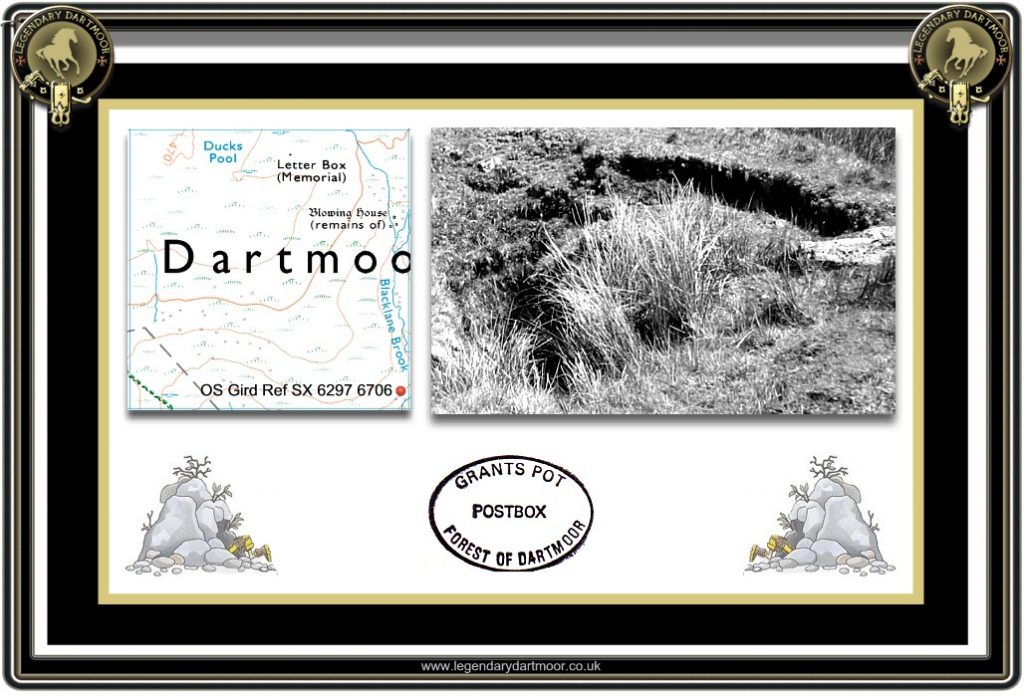
There are numerous place-names on Dartmoor that makes one ponder as to why they were called such. Back in the April of 2014 I received the following email which gave me cause for thought.
“I have just been browsing your website with much interest and I wonder if you could possibly tell me if Grant’s Pot is still in operation? I am writing this on behalf of my husband, John Grant, the founder of the Pot, who is unable to contact you himself due to ill health following a stroke. I know he would be so interested in hearing any news regarding the Pot. It is several years since he has been able to go out on the moor and he is now 84 years of age.”
As mentioned above, there are quite a few place-names on Dartmoor that have personal elements in them but the majority of them date back centuries and there is little hope of finding the actual living person after who the location is named Thankfully this is one example where the place-name history of a well known location can be traced and the background of how the name came into being was firmly fixed to it. You will not find Grant’s Pot on any Ordnance survey map but its existence and location is only too well known to many letterboxers and walkers. You will however find mention of Grant’s Pot in Eric Hemery’s book – High Dartmoor where he says the following: “Below Black Rocks the valley narrows towards the glen of Stony Hole, where is a large stream-work reaching to its very foot. An old adit known as ‘Grant’s Hole’, or Pot (harbouring yet another post-box) lies under the right bank near a twist in the brook …”, Hemery, p.276. As you can see, Mr. Hemery was none too keen on the ‘post-box‘ phenomenon but I would suggest that it’s thanks to this that ‘Grant’s Pot’ is a recognised location today. Having been inside the ‘pot’ on several occasions I must humbly disagree with Hemery insomuch as I would say it is not an adit (also which I have been in many) but a natural cavern. All this is fine but what needs to be clarified is exactly why the cave became known as Grant’s Pot.
The ‘post-box’ Hemery refers to was one of the first original fifteen letterboxes established on Dartmoor. Back in 1976 Broomhead Publications published the ‘Dartmoor Letterboxes – Souvenir Guide map’. The guide was a fold-out map with 15 boxes in which to stamp what was then the only the existing letterboxes – Number 14 was the Grant’s Pot letterbox. There was also a brief description of the location and the history of its letterbox. It said; “Grant’s Pot is a small underground cavern, discovered in 1953 by the Senior Scouts of the 4th Teignmouth Group. It was intended immediately to set up a letterbox at this spot, but this was not done until June 1972 when the box, dedicated to all who love the moor, was placed by senior pupils of Dawlish Secondary School.” A copy of this early stamp can be seen in the collection opposite along with others since sited in or around Grant’s Pot. To further add to the information which appeared in the ‘Souvenir Guide Map’ Mrs Sue Grant via John has kindly supplied more detail. Yes, the cave was discovered by the Senior Scouts of the 4th Teignmouth Group of which John Grant was the Scoutmaster. He had a great deal of previous experience of pot holing gained in the Pennines which prompted the exploration of the cave. John was unsure as to whether the naming of the cave after him was an honour or a joke. It was not for another nineteen years that the pupils of Dawlish Secondary School placed the original letterbox in Grant’s Pot. John was a senior teacher at Dawlish school and would often take his pupils out onto the moor which is how the letterbox became sited. Unfortunately by the 1990s John was unable to visit the cave and so another letterboxer, Gerald Tickner, offered to maintain the letterbox and has done since 1998. Sadly John passed away in 2020 but over the years he had kept a collection of early photographs and the various visitor books that once dwelt in the cave over.
Today the cavern is covered by thick vegetation and involves some cramped crawling to gain entry into what at times can be a wet and muddy hole. Whether or not there is still a letterbox inside is open to speculation as it or they seem to disappear and re-appear. This could well be due to the fact that some folk could not find the letterbox and simply reported it as missing. There is/was another resident in the cave in the form of a modern geocache, the forerunner to letterboxes – say no more. As 2022 is the fiftieth anniversary of the siting of the first stamp in Grants Pot Gerald Tickner is aiming to sight, “intending to install some additional stamps based on the original designs.”
Whilst on the subject of subterranean caverns there is another but much larger one not far from Grant’s Pot. This one is known as Phillpott’s Cave and takes its name from Eden Phillpotts the famous Dartmoor author. “Marshy banks enclose Wollake as it flows onwards, until the valley narrows and conspicuous rocks appear above both banks. Those on the east side of the valley provide a surprise in the shape of a cavern spacious enough to shelter three people. The immense roof slab measures thirty-five feet by thirteen feet. Gaps between the slab and supporting boulders have been plugged with stones, but the orientation of the opening to the north is distinctly chilling except in warm weather. The cavern is known as Phillpott’s Cave.” Way back in the day the cave was used as a summer shelter for one John Spencer who worked on the culverts and track belonging to Black Lane. When in residence he used the cave to sleep in and cook his meals. In the early 1900s the author Eden Phillpotts renovated this Dartmoor ‘des-res’ by filling in the natural wall gaps with turf. He also stocked the cave with supplies of preserved food along with a tot or two of well hidden whisky. His intent was that the cave could be used as temporary residence for any moorman or hiker in need of shelter, Hemery, p.275. Although the stash of food and whisky has long gone it has been known for the cave to be inhabited as recently as 2011 by some wild camper who seems to have made themselves quite at home. There is one more theory as to how this cavern became known as Phillpott’s Cave and that is down to one Tony Phillpotts. He was a hunt servant who stashed food and drink in the cave as refreshments when his hunt met in the area, this saved carting it around each time whilst out hunting. Earle, p.130.

Earle, J. 2002. Walking on Dartmoor. Milnthorpe: Cicerone Press Ltd.
Hemery, E. 1983. High Dartmoor. London: Robert Hale.
 Legendary Dartmoor The many aspects past and present of Dartmoor
Legendary Dartmoor The many aspects past and present of Dartmoor


